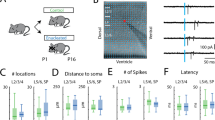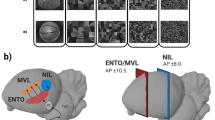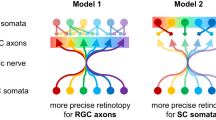Abstract
MANY hypotheses have been proposed to account for the development of the exquisitely specific systems of neuronal connections in the brain. Axons might read chemical labels on their target cells, attaching only to cells with a matching label1; axon and target cell populations might arrange a match without cell-to-cell specificity, using such mechanisms as differential advantage in competition for terminal space2,3; or some feature of the development and maturation of an axon and target system might produce ordered patterns of connectivity. The principal model system used to test these hypotheses has been the retinotectal projection of animals with nervous systems which are capable of regeneration, although it is not known whether this system in fact behaves like a developing nervous system. After removal of half the tectum in goldfish or frog, for example, an entire retina will compress its representation uniformly onto the remaining half tectum4,5. We have repeated this experiment in the developing mammalian brain, and have found that following a partial tectal ablation in a neonatal hamster, the projection from the retina to the superior colliculus will terminate in an orderly way in a smaller than normal tectal volume, as in goldfish and frog1,4. However, we have found preferential representation of nasal visual field which has not been reported in studies of non-mammalian animals in which the optic tract axons can regenerate. This may suggest some fundamental differences in developing and regenerating systems; in any case, it poses new problems for theories of neuronal specificity in developmental neurobiology.
This is a preview of subscription content, access via your institution
Access options
Subscribe to this journal
Receive 51 print issues and online access
$199.00 per year
only $3.90 per issue
Buy this article
- Purchase on Springer Link
- Instant access to full article PDF
Prices may be subject to local taxes which are calculated during checkout
Similar content being viewed by others
References
Meyer, R. L. & Sperry, R. W. In Studies in the Development of Behavior and the Nervous System 3: Neural and Behavioral Specificity (ed. Gottleib, G.) (Academic, New York, 1976). Meyer, R. L. Expl Neurol. 56, 23–41 (1977).
Keating, M. J. & Kennard, C. In The Amphibian Visual System (ed. Fike, K. V.) (Academic, New York, 1976).
Gaze, R. M. & Keating, M. J. Nature 237, 375 (1972).
Gaze, R. M. & Sharma, S. C. Expl Brain Res. 10, 171 (1970).
Udin, S. B. J. comp. Neurol. 173, 561 (1977).
So, K.-F., Schneider, D. E. & Frost, D. O. Anat. Rec. 187, 719 (1977).
Jhaveri, S. R. & Schneider, G. E. Anat. Rec. 178, 383 (1974).
Jhaveri, S. R., thesis, Massachusetts Institute of Technology, 1974.
Schneider, G. E. In Neurosurgical Treatment in Psychiatry (eds Sweet, W. H., Obrador, S. & Martin, J. G.) (University Park Press, Baltimore, 1977).
Finlay, B. L., Schneps, S. E., Wilson, K. G. & Schneider, G. E. Brain Res. 142, 223 (1978).
Finlay, B. L. thesis, Massachusetts Institute of Technology, 1976.
Author information
Authors and Affiliations
Rights and permissions
About this article
Cite this article
FINLAY, B., SCHNEPS, S. & SCHNEIDER, G. Orderly compression of the retinotectal projection following partial tectal ablation in the newborn hamster. Nature 280, 153–155 (1979). https://doi.org/10.1038/280153a0
Received:
Accepted:
Published:
Issue Date:
DOI: https://doi.org/10.1038/280153a0
Comments
By submitting a comment you agree to abide by our Terms and Community Guidelines. If you find something abusive or that does not comply with our terms or guidelines please flag it as inappropriate.



